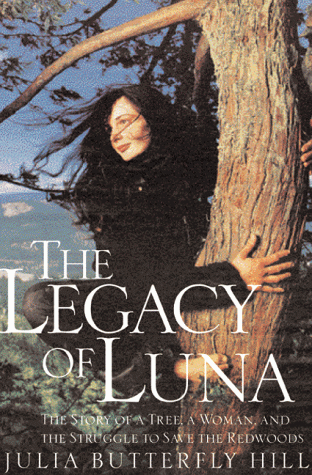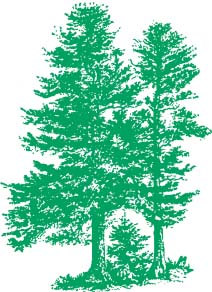|
The Forest Ecology Network
Bookshelf
The Legacy of Luna: The Story of a Tree,
a Woman, and the Struggle to Save the Redwoods
by Julia Butterfly Hill
Hardcover - 256 pages 
April 2000
Harper San Francisco; ISBN: 0062516582
On December 18, 1999, Julia Butterfly Hill's feet touched
the ground for the first time in over two years, as she descended
from "Luna", a thousand-year-old redwood in Humboldt
County, California.
Hill had climbed 180 feet up into the tree high on a mountain
on December 10, 1997, for what she thought would be a two- to
three-week-long "tree-sit". The action was intended
to stop Pacific Lumber, a division of the Maxxam Corporation,
from the environmentally destructive process of clear-cutting
the ancient redwood and the trees around it. The area immediately
next to Luna had already been stripped and, because, as many
believed, nothing was left to hold the soil to the mountain,
a huge part of the hill had slid into the town of Stafford, wiping
out many homes.
Over the course of what turned into an historic civil action,
Hill endured El Niño storms, helicopter harassment, a
ten-day siege by company security guards, and the tremendous
sorrow brought about by an old-growth forest's destruction. This
story - written while she lived on a tiny platform eighteen stories
off the ground - is one that only she can tell.
Twenty-five-year-old Julia Butterfly Hill never planned to
become what some have called her - the Rosa Parks of the environmental
movement. She never expected to be honored as one of Good Housekeeping's
"Most Admired Women of 1998" and George magazine's
"20 Most Interesting Women in Politics," to be featured
in People magazine's "25 Most Intriguing People of the Year"
issue, or to receive hundreds of letters weekly from young people
around the world. Indeed, when she first climbed into Luna, she
had no way of knowing the harrowing weather conditions and the
attacks on her and her cause. She had no idea of the loneliness
she would face or that her feet wouldn't touch ground for more
than two years. She couldn't predict the pain of being an eyewitness
to the attempted destruction of one of the last ancient redwood
forests in the world, not could she anticipate the immeasurable
strength she would gain or the life lessons she would learn from
Luna. Although her brave vigil and indomitable spirit have made
her a heroine in the eyes of many, Julia's story is a simple,
heartening tale of love, conviction, and the profound courage
she has summoned to fight for our earth's legacy.
Reading the Forested Landscape : A Natural
History of New England
by Tom Wessels, illustrated by Brian D. Cohen
Paperback - 200 pages
Reprint edition June 1999 
Countryman Press ISBN: 0881504203
Reading the Forested Landscape will help many thousands of New
Englanders answer the questions that come to mind as they wander
this landscape of stone walls, stunted apple trees, and towering
hemlocks. First of all, the book plainly deserves readers outside
of New England. While the particular forests the book looks at
are in the northeast, Tom Wessels' approach and style won't be
lost on anyone with an interest in natural history.
The bedrock of the book is patient, graceful storytelling.
At the outset of each chapter, Wessels shows us a simple print
of a forest. He asks us to wonder what made that forest, and
then he leads us, in unaffected voice, through his thinking as
he answers that question. Why is this maple here? Are the trees
here fire damaged? Wessels describes the outlines from which
we can read a larger story. Each chapter is in a sense a little
mystery.
It's apparent how carefully Reading the Forested Landscape
was crafted. This isn't just a collection of portraits; the chapters
progress from one to the next intelligently. For example, you
learn how to recognize a fire in one chapter; at the beginning
of the next, Wessels starts by asking whether a similar fire
has taken place in this new spot. That's a simple transition,
but it really helps you stay in the flow of the writing. The
author's smart enough to reinforce what you've learned at the
same time that he's establishing continuity in the larger story.
This book reads through wonderfully.
And there's a bigger picture you're reading toward, too. Each
chapter also includes a broader natural history subject related
to its particular forest. You've seen a few trees, and you've
puzzled out the sort of setting you're looking at; now, by touching
on a bigger natural historical theme, you place that forest in
the natural world as a whole. Reading the Forested Landscape
does a wonderful job of drawing you into that big picture. How
can we look at an eastern forest without thinking of the Chestnuts
that dominated there until early this century? Sure, maybe those
trees are gone now, but they're part of this story.
Wessels delightful book really will tell you how to read the
forested landscape of New England, and he manages to do so with
charm and style. A walk in the woods will never leave you puzzled
again.
The Hidden Forest : The Biography of an
Ecosystem
by Jon R. Luoma
Paperback - 228 pages (May 2000) 
Henry Holt (Paper); ISBN: 0805064486
Tucked away into the verdant folds of the Cascade foothills
east of Eugene, Oregon, there is a forest that has been forming
since before Columbus first set foot in the New World. The 16,000-acre
Andrews Experimental Forest is an old-growth forest, a description
largely unknown to the American public until the late 1980s,
when the spotted owl swooped into notoriety. In some forestry
circles, other adjectives like decadent are used to describe
this forest's towering Douglas firs, western red cedars, and
western hemlocks-that is, a forest that has reached maximum wood
fiber capacity. Loggers contend that allowing such giant trees
to die, rot, and fall over is a waste of resources. "I'm
clearcutting to save the forest," declared a partisan newspaper
ad in the go-go timber years of the 1970s, when old growth was
liquidated at an unprecedented rate to make way for managed forest
crops. The only problem with this view is that it misses the
forest for the trees. In The Hidden Forest, Jon Luoma takes the
reader on an intimate, guided tour below-and above-the canopy
to view the natural processes of an ancient forest and visit
with the scientists working there
The Andrews Experimental Forest is unique in that it brings
together scientists from diverse fields to join a collaborative
effort, with the end result being an entire ecosystem under the
microscope. In the heart of summer research season, scientists
can be found burrowing in the soil under logs; or trapping insects
fifteen stories or more up in the tree canopy with the aid of
rock-climbing gear; or scrambling crablike in a neoprene wet
suit in a rushing, buffeting mountain stream....
One optimistic scientist is examining the process of rot in
fallen trees, a study that will take two centuries in the case
of these old-growth logs, meaning that "it will be up to
the contemporaries of [his] great-great-great-great-grandchildren
to complete the analysis he has begun." Others are busy
identifying thousands of species new to science. To date, this
research has yielded a "wellspring of key discoveries,"
turning the environmental and scientific communities upside-down.
But meanwhile, the last remnants of unprotected Pacific old-growth
forest continue to fall to the chainsaw. "It remains to
be seen," writes Luoma, "how long it might take some
entrenched U.S. Forest Service managers to fully embrace more
ecosystem-based approaches." The Hidden Forest is testimony
as to why sooner is better than later.
|

